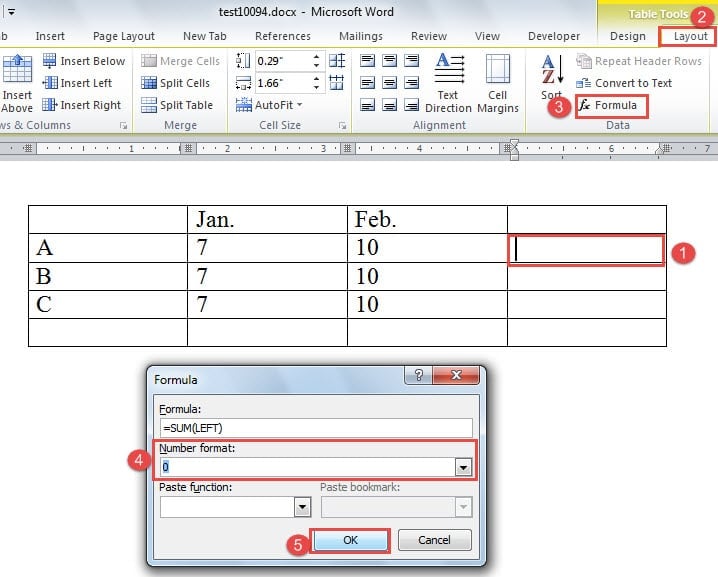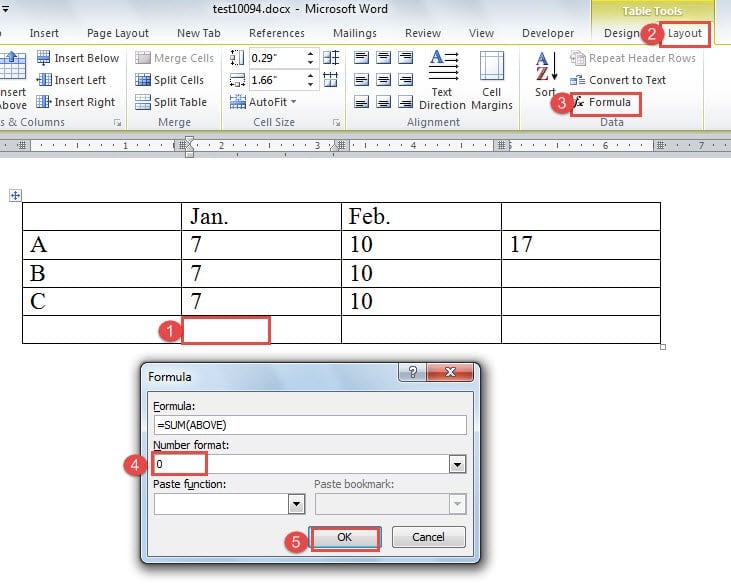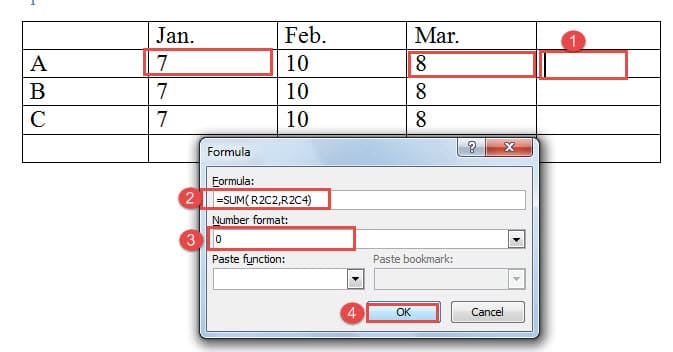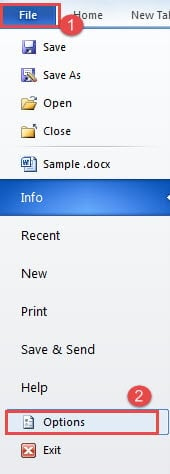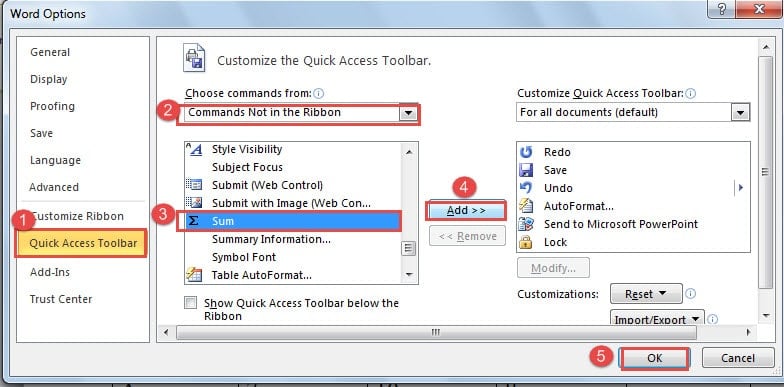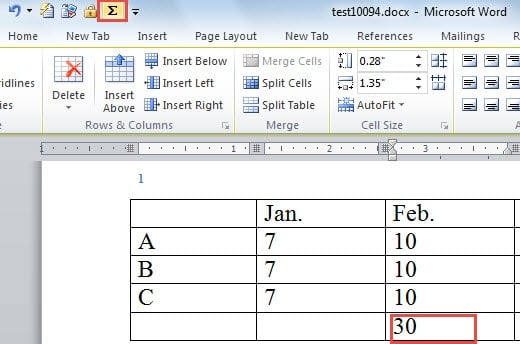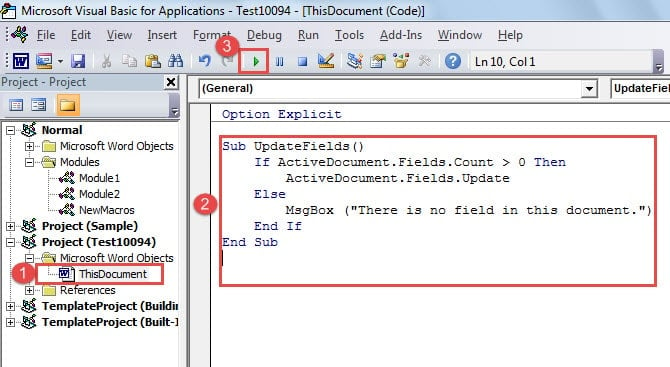In this article, we will propose you 3 quick ways to sum numbers in your Word table along with the methods to update values.
It’s been a universal knowledge that we can easily sum numbers in table cells in Excel. As a matter of fact, Word is capable of this function too. To know quick ways to sum a column or a row of numbers in Word table definitely can save us much time.
Before introducing the detailed steps, you should aware that the rule to name a cell is exact the same as that of Excel. So “R” stands for “Row”, and “C” for “Column”. For example, “R1C2” refers to the cell in first row and second column.
Now let’s move on to see what these clever methods are.
Method 1: Use “Formula”
- First of all, put your cursor in the cell where the value goes. For instance, here we put it in “R2C4” cell.
- Then, click “Layout” tab under “Table Tools”.
- Next, click “Formula” in “Data” group.
- In “Formula” dialog box, you can see “=SUM(LEFT)” in “Formula” text box. It means Word will sum all numbers in the left of “R2C4”. Likewise, if you want to sum a column of numbers, the formula will display as “=SUM(ABOVE)”.
- Then continue to click the drop-down button and choose a number format for the value.
- Finally, click “OK” and you will get the result in target cell.
Besides, if you need to sum a series of intermittent cells, you should input the exact cells’ names between the parentheses of formula, and separate them with comma. For example, the formula to sum “R2C2” and “R2C4” should be “=SUM(R2C2, R2C4)”.
Method 2: Insert a Field
- Firstly, place cursor properly as in method 1.
- Then press “Ctrl+ F9” to insert a field in the cell.
- Next input formula. For instance, to sum “R2C2” and “R2C3”, the formula should be “= R2C2+ R2C3”.
- Lastly, press “F9” and you can get a value.
Method 3: Use “Sum” Command
- To begin with, you’d better add “Sum” command to “Quick Access Toolbar”. Just start with clicking “File”.
- Then choose “Options”.
- In “Word Options” dialog box, choose “Quick Access Toolbar”.
- And choose “Commands Not in the Ribbon” in “Choose commands from” list-menu.
- Then find and click “Sum” command.
- Next, click “Add”.
- And never forget to click “OK”.
- The next thing is to position cursor in the right cell.
- And click “Sum” command on “Quick Access Toolbar”.
2 Methods to Update Values
It’s understandable that numbers in a table shall change overtime. At that time, to update the sum value should come to your top priority. Here are 2 ways to save you from manually updating values.
Method 1: Press “F9”
- First you select the table by clicking the plus sign on the upper-left corner.
- Then press “F9” to update.
However, this method is not that ideal when it comes to a document containing a large number of tables. So the alternative way is to use VBA codes.
Method 2: Use VBA Codes
- Firstly, make sure you have “Developer” tab available in the Ribbon. If not, please refers to this article: How to Insert Background Music into Your Word Document
- Click “Developer” and click “Visual Basic” in “Code” group.
- Now you will have the VBA editor open. On the “Project Explorer” left-side, find and double click “ThisDocument” to open code editing area on the right.
- Next, you can copy and paste the following codes there.
Sub UpdateFields()
If ActiveDocument.Fields.Count > 0 Then
ActiveDocument.Fields.Update
Else
MsgBox ("There is no field in this document.")
End If
End Sub
- Lastly, click “Run”.
Comparison of 3 Methods to Sum Numbers
| Methods | Advantages | Disadvantages |
| Method 1: Use “Formula” | 1. You can sum a row or column of numbers.
2. You can choose a number format. 3. It has default formula to sum a row or column of numbers, so you don’t need to enter formula. |
It requires more steps comparatively. |
| Method 2: Insert a Field | 1. You can sum a row or column of numbers.
2. Fewer steps comparatively |
1. You can’t choose a number format.
2. You have to enter formula manually. |
| Method 3: Use “Sum” Command | 1. Fewer steps comparatively
2. You don’t have to enter formula manually. |
3. You can only sum a column of numbers.
4. You can’t choose a number format. |
Address File Corruption Problem Smartly
Once a file gets corrupted, most people know that they should run the built-in function in Word to repair their file. However, this built-in function fails to meet people’s need sometimes. Then the smart way is to choose a specialized Word file corruption repair tool. With such a powerful tool at hand, you shall have no concern for losing files.
Author Introduction:
Vera Chen is a data recovery expert in DataNumen, Inc., which is the world leader in data recovery technologies, including xlsx repair product and pdf repair software products. For more information visit www.datanumen.com
Insert Page X of Y
If you have a header or footer already, click or tap where you want to put the page number first.
-
Go to Insert > Page Number.
-
Do one of the following:
-
Select Current Position if you have a header or footer.
-
Select a location if you have no header or footer yet.
-
-
Scroll until you see Page X of Y and select a format.
-
Select Close Header and Footer, or double-click anywhere outside the header or footer area.
-
Double-click in the footer or header where you want page numbering.
-
Go to Header & Footer > Footer, and then scroll to find and select Semaphore.
-
Select Close Header and Footer or double-click anywhere outside of the header or footer areas to exit.
See also
Start page numbering later in your document
-
Go to Insert > Page Numbers
-
Select Include Page Count for an X of Y format.
-
Choose a location.
To remove page numbers, repeat these steps but choose Remove Page Numbers.
William C Johnson
asked on 3/9/2019
How do I total a column of numbers in a Word 2010 that are not in a table? Is this math feature possible?
100
200
300
Microsoft Word
THIS SOLUTION ONLY AVAILABLE TO MEMBERS.
View this solution by signing up for a free trial.
Members can start a
7-Day free trial
and enjoy unlimited access to the platform.
THIS SOLUTION ONLY AVAILABLE TO MEMBERS.
View this solution by signing up for a free trial.
Members can start a
7-Day free trial
and enjoy unlimited access to the platform.
Thank you and I was please to assist you.
You are here
If you’re using Word to present a table of data that includes numbers, you can use Word’s built in formulas to add up those numbers rather than manually calculate them each time they change. This can also eliminate the possibility of error — particularly important if you’re producing a sales proposal or an important report.
Note that you can’t just add up numbers on different lines — you can only add up numbers that are presented in either a column or a row inside a table.
First, create your table and decide which column or row will hold the numbers you wish to add up. Enter the numbers, making sure that there is a number in each cell in the column.
Then, in the last row in the table, click in the cell in the number column and choose Insert > Quick Parts > Field, then click Formula
A new dialog box should appear containing a Formula field with one of the following formulas:
=SUM(ABOVE)
=SUM(LEFT)
Note — if you get an error rather than one of these formula, it most likely means that Word couldn’t find any numbers in the cells above or to the left of the current cell.
You can now choose a format for the number. The list of available number format is somewhat limited, but you can manually enter any format that is supported by Excel. For example, the following format is not listed but will work to format the number with a $ sign, thousand separators and two decimal places:
$#,###.##
Once you’ve chosen a format, you can click OK.
This will insert the SUM formula into the cell. Word will then calculate the sum of all the cells above the cell where the formula is located provided they all contain numbers.
If you find that Word does not calculate the sum of all the numbers in the column, it is possible that one of the cells does not contain a valid number. This gives rise to two possibilities:
- Word will ignore any cells containing non-numbers (i.e. text) in the column above and add up the rest of the cells. In some cases, you may have typed a number which Word sees as text instead. Try retyping these numbers to see if that fixes the problem.
- Word encounters an empty cell. Once it hits an empty cell, Word stops calculating. Any cells above the empty cell will be ignored. If this happens, you may need to rearrange the order of the rows in the table, or consider putting a text value into the empty cells.
.
Want to learn more? Try these lessons:
.
.
Our Comment Policy.
We welcome your comments and questions about this lesson. We don’t welcome spam. Our readers get a lot of value out of the comments and answers on our lessons and spam hurts that experience. Our spam filter is pretty good at stopping bots from posting spam, and our admins are quick to delete spam that does get through. We know that bots don’t read messages like this, but there are people out there who manually post spam. I repeat — we delete all spam, and if we see repeated posts from a given IP address, we’ll block the IP address. So don’t waste your time, or ours. One other point to note — if you post a link in your comment, it will automatically be deleted.
Add a comment to this lesson
.
Comments on this lesson
This is helpful, but one must
This is helpful, but one must remember that if you change the numbers in the table, you need to recalculate the total. It doesn’t update automatically, as it does in Excel.
.
Recalculating totals when the numbers change
Thanks for pointing this out. You’re right that the numbers won’t update automatically. You can update a total by right-clicking the total and choosing the Update Field option. If you have multiple total fields (or other types of Word fields, such as a table of contents or cross references to other parts of your document) you can trick Word into recalculating all of them by pressing CTRL+P (or simply choosing the Print option). You don’t actually have to print the document, but this will force Word to recalculate the fields in your document.
.
What about the formatting of the input numbers
It appears the numbers captured in the table need to be «unformatted» (e.g. 1000000 instead of $1,000,000) for them to be added up. Is there a way around this?
.
Adding up formatted numbers in a Word table
Hmmm. In my experience, adding up numbers with formatting such as you’ve shown is no problem at all. Perhaps there is something else happening in your table? Happy to take a look at an example document if you would like to get in touch directly via the Contact page.
.
Adding Up Numbers in Word
I have tried these instructions at least twice. The numbers aren’t adding up correctly. I have Word 2013. Does this make a difference in the «how to» instructions?
.
Added up different lines not just the whole column
you certainly can just add up different lines e.g. =SUM(B2:B3) just like in Excel. You just have to image the rows and columns numbered like an Excel spreadsheet. And if you put a number in brackets e.g. (£750.00) it will subtract the amount.
.
Sum word table cells with numbers in bracket
Word 2016 will sum correctly all numbers in text whether there are thousand separators and brackets.
But Word 2007 could not sum text like «-» or number in brackets
.
Sum Numbers in MS Word
So we have an invoice with a subtotal, then add tax for final total, etc. But how do we image to discover what the Subtotal & Tax fields are to add for the final total?
.
auto sum in word
i did above steps and i am able to do auto sum but my problem is, i need to use that word file with Autosum function as a template and send it to all employee. i saved the word and re open it and when i enter data it do not automatically auto sum it. how can i fix this?
.
.
.
.
.
Okay, I’m going to start with the assumption that most people will know how to create a simple table in Microsoft Word 10. I’m further going to assume that most people are like me, and put their headings in the first row – so we know what data to enter where. The assumption about the headings is important because it will have an impact later on.
So, I created the following table with dummy data :
Given how few items there are in this table you could easily do the sums in your head and just type them in. But why whip out the calculator when the table should be able to do the sums for you?
The first sum we need to do is to multiply the unit cost of Part #123 by the Unit Qty – i.e. 100 x 2. For this we will need the formula using PRODUCT. This is what we want to see :
And this is how we do it :
Click inside the Sub-Total cell of Part #123. Next, click the ‘Layout’ tab at the top of your screen, and select ‘Formula’.
A popup will appear :
Under Formula, Word automatically displays the formula it thinks you might want to use. ‘=SUM(LEFT)’ is not the one we want so either backspace over it, or highlight the whole thing and delete.
Hit the equals sign on your keyboard [‘=’]. Now click the arrow next to ‘Paste function’ to display the list of available functions. The one we want is PRODUCT.

While you’re there, click the arrow next to ‘Number format’, scroll down the list and select the decimal format. Click OK and Word will multiply all the numbers to the left of the current cell until it reaches a blank cell, or, as in our case, it reaches some plain text. The number that results from that multiplication will be inserted into the Sub-Total field of the table.
Now, as we all know that 500 x 1 = 500, you could just type the next two numbers in the Sub-Total fields, but use Product instead for practice. When you’re done, your table should look like this :
Now we’re going to add up those three numbers, and have Word put the result in the Total column. But before we do that I need to explain about co-ordinates.
In spreadsheets, the column names and row numbers are always visible, like so :
In Word tables, however, we have to imagine those nice, neat co-ordinates. I didn’t imagine them properly and spent hours trying to work out why my formulas weren’t working. You see, I counted the first row of data as row 1. Wrong. That honour goes to the column headings I put in. Thus the co-ordinates I need to enter into the formula to add up the three Sub-Total amounts are e2:e4 [not e1:e3].
Onwards.
Click inside the empty cell in the Total column, go to Layout, Formula. Because Word can’t find any numbers to work with, the popup just shows the equals sign [‘=’]. As before, display the list of available functions, but this time, select SUM.
With the cursor inside the SUM brackets, type :
e2:e4 [e2 colon e4]
Remember to select the decimal number format, and the popup should look like this :
Click OK and our table should now look like this :
Just two more formulae to do!
No quote or invoice would be complete without our beloved GST. We could just move the decimal point one place to the left to get our 10% GST, but that would be too easy. 😉
In the empty cell next to GST, click inside the cell, open Layout, select Formula and delete the existing formula from the popup. This time we are doing it ALL manually.
The Total column corresponds to column F, so the total amount for parts corresponds to f5 [because the headings are on row 1].

Now we need to write a formula to divide f5 by 10. The formula is :
=(f5/10)
Note : the ‘divide’ sign is found on the top of the numeric key pad of your keyboard. Don’t forget to select decimals as the number format. Click OK and you should see something like this :
Our last task is going to be the easiest of the lot. All we have to do is add the GST amount to the figure for total Parts.
Click inside the empty TOTAL cell, click on Layout [unless you’ve already done so], and select Formula. The popup shows the exact formula we need, already selected for us – i.e. =SUM(ABOVE). This formula will add up all the numbers that occur above the cell in which the formula is located. That means it will add Parts and GST only because we kept the rest of the column empty.
Before we click OK, select $ from the number format list in the popup :
Now click OK and see the results of our hard work!
And of course, the $ sign is in the wrong place. -sigh- To make this beast look as pretty as we can, we’re going to make the Total column fit the widest entry in it.
Move your cursor to the top of the Total column. When it changes to a down arrow, click to highlight the whole column :

The Total column is now wide enough to show the $ sign properly, however the numbers still don’t line up nicely with the right hand side of the column.
With the Total column still highlighted, search the Layout tab until you find the ‘Align right’ icon :
Click, and ta dah!
Before I shuffle off for a well-deserved cup of coffee, I have to say that this has been a lot of work to achieve something Excel probably could have done faster. The point is though, with a spreadsheet you end up with a spreadsheet. With Word tables, you end up with something that can be incorporated into a complete, professional looking document. That said, I wouldn’t dream of using a table for masses of data – that is not what it is designed for. Tables are a quick [once you know what you’re doing] and dirty tool for smallish jobs.
Remember, use the right tool for the right job. 🙂
Okay, I’m done.
Cheers
Meeks

